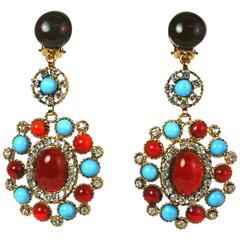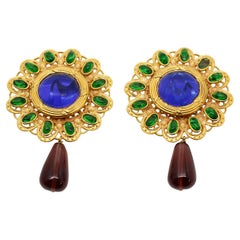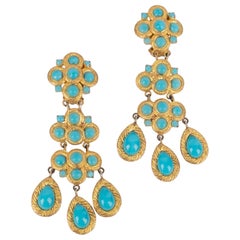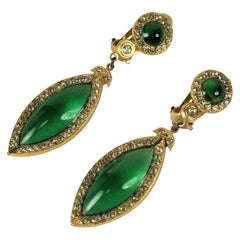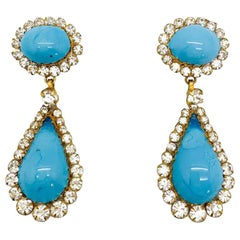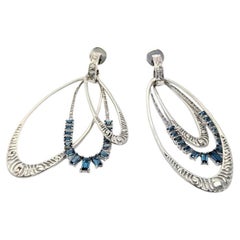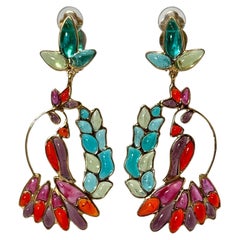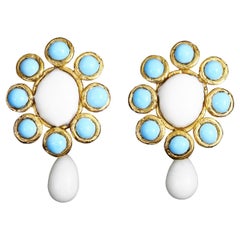Maison Gripoix Drop Earrings
to
2
1
1
5
1
3
5
81
981
309
269
257
1
4
1
3
2
Creator: Maison Gripoix
Elegant Maison Gripoix Poured Glass Earrings
By Maison Gripoix
Located in New York, NY
Elaborate and elegant Maison Gripoix Poured Glass earrings from the 1980's. Large scaled in vibrant contrasting tones of ruby and turquoise glass...
Category
1980s French Vintage Maison Gripoix Drop Earrings
Materials
Gilt Metal
Maison Gripoix Vintage Blue, Green and Red Dangling Earrings Circa 1980s
By Maison Gripoix
Located in New York, NY
Maison Gripoix Vintage Blue, Green, and Red Dangling Earrings. These will always look classic and in style. This look never leaves the mood board....
Category
1980s French Modern Vintage Maison Gripoix Drop Earrings
Materials
Mixed Metal
Gripoix Antique Earrings with Blue Glass Paste
By Maison Gripoix
Located in SAINT-OUEN-SUR-SEINE, FR
Gripoix - (Made in France) Golden metal earrings with blue glass paste.
Additional information:
Condition: Very good condition
Dimensions: Height: 8 cm
Seller Reference: BO9
Category
1970s French Vintage Maison Gripoix Drop Earrings
Butler Wilson Emerald Poured Glass Earrings, Gripoix
By Maison Gripoix
Located in New York, NY
Butler Wilson Emerald Poured Glass Earrings made by Maison Gripoix in the 1980's. B+W commissioned Maison Gripoix to manufacture models for them for a short period. Gilt frames set w...
Category
1980s French Vintage Maison Gripoix Drop Earrings
Materials
Brass, Gilt Metal
Vintage Maison Gripoix Pate De Verre Poured Turquoise Glass Teardrop Earrings
By Maison Gripoix
Located in Wilmslow, GB
An exceptional pair of early French Vintage Maison Gripoix Earrings dating to at least 1940s, possibly earlier. The legendary House of Gripoix played perhaps the greatest role in the...
Category
20th Century Maison Gripoix Drop Earrings
Related Items
Interchangeable Earrings in Sterling with Blue Topaz Baguettes
By Martha Seely
Located in Carlisle, MA
The Interchangeable Earring Ensembles are the foundation of the Lyra Collection. Lightweight and playful, this ensemble consists of the huggie ...
Category
2010s American Contemporary Maison Gripoix Drop Earrings
Materials
Topaz, Blue Topaz, Sterling Silver
Drop Huggie Earrings, 14 Karat Yellow Gold Hoop Spike Drops, Huggie Earrings
Located in Austin, TX
These stunning 14k yellow gold spike drop huggie hoops provide a look that is both trendy and classic. These earrings are a great staple to add to your collection, and can be worn wi...
Category
2010s American Modern Maison Gripoix Drop Earrings
Materials
Gold, 14k Gold, Yellow Gold
$629 / set
W 0.06 in Dm 0.46 in L 0.77 in
Vintage Circa 1980s 18k Gold Natural Diamond Decorated Drop Earring
Located in Fatih/İstanbul, 34
In very good condition.
Total weight is 3.4 grams.
Totally is diamond 0.82 ct.
The diamond is has G color and vs clarity.
Box is not included.
Please contact for any questions.
Category
1980s European Retro Vintage Maison Gripoix Drop Earrings
Materials
Diamond, 18k Gold
Syna Yellow Gold Amethyst Earrings
By Syna Jewels
Located in Fort Lee, NJ
Created in 18 karat yellow gold
Amethyst 11 carats approx.
18kyg butterfly backs
Limited edition
About the Designers ~ Dharmesh & Namrata
Drawing inspiration from little things, D...
Category
2010s Unknown Contemporary Maison Gripoix Drop Earrings
Materials
Amethyst, 18k Gold, Yellow Gold
18k Gold Pale Green Prehnite and Diamond Hook Earrings
By Angelina Fine Jewelry
Located in Amsterdam, NH
A very elegant pair of 18k gold soft green prehnite and diamond earrings. (Total diamond carat weight 0.03). Handmade and one of a kind. The dark green needle-like inclusions of the ...
Category
2010s Dutch Artisan Maison Gripoix Drop Earrings
Materials
Diamond, Other, 18k Gold
Handcraft Rock Crystal 18 Karat White Gold Onyx Drop Earrings
By SCALA GIOIELLI
Located in Marcianise, IT
For any problems related to some materials contained in the items that do not allow shipping and require specific documents that require a particular period, please contact the selle...
Category
21st Century and Contemporary Italian Artisan Maison Gripoix Drop Earrings
Materials
Onyx, Rock Crystal, Crystal, 18k Gold, White Gold
Amethyst and Diamond Drop Earrings in 18k Yellow Gold, 6.72 Carats Total
By Sarosi By Timeless Gems
Located in Los Angeles, CA
These stunning drop earrings feature rich purple amethysts and brilliant diamonds in a design that will add everyday elegance to your wardrobe! Stylish and modern but with timeless a...
Category
21st Century and Contemporary American Artisan Maison Gripoix Drop Earrings
Materials
Amethyst, White Diamond, Diamond, 18k Gold, Yellow Gold, Gold
14K Yellow Gold Diamond Stud & Half Loop Earrings, 8gr
Located in Laguna Beach, CA
J curve diamond earrings in 14k yellow gold settings.
Tests 14k and weigh 8.2 grams.
The diamonds are round brilliant cuts, approximately 1.20 ...
Category
20th Century Maison Gripoix Drop Earrings
Materials
Diamond, Yellow Gold, 14k Gold
Imperial Topaz with Brown Diamond Earrings Set in 18 Karat Rose Gold Settings
Located in Bangkok, TH
Imperial Topaz 6.19 carats with Brown Diamond 0.70 carat Earrings set in 18 Karat Rose Gold Settings
Width: 1.1 cm
Length: 2.5 cm
Total Weight: 7.99 grams
"We first opened doors...
Category
2010s Thai Contemporary Maison Gripoix Drop Earrings
Materials
Brown Diamond, Topaz, Imperial Topaz, 18k Gold, Rose Gold
$3,980
W 0.44 in L 0.99 in
Burma Ruby and Diamond Chandelier Drop Earrings. 4.7cm. Can Be Worn Two Ways!
Located in Hong Kong, HK
Please check out the HD video! Here is a pair of nice marquis Ruby and diamond chandelier drop earrings. The earrings are set in 18k white gold and white diamonds. The earrings can b...
Category
2010s Hong Kong Contemporary Maison Gripoix Drop Earrings
Materials
Diamond, White Diamond, Ruby, Gold, 18k Gold, White Gold
18 Karat White Gold 1.59 Carat Diamond Dangle Earrings
By Gems Paradise
Located in Jaipur, IN
18 Karat White Gold 1.59 Carat Diamond Dangle Earrings
This incredible invisible set emerald cut diamond long hanging earring is timeless. The i...
Category
2010s Indian Contemporary Maison Gripoix Drop Earrings
Materials
Diamond, Gold, 18k Gold, White Gold
Vintage Circa 1980s 14k Gold Natural Diamond Decorated Drop Earring
Located in Fatih/İstanbul, 34
In very good condition.
Total weight is 10.9 grams.
Totally is diamond 1.30 ct.
The diamond is has H-I color and s1-s2 clarity.
Box is not included.
Please contact for any questions.
Category
1980s European Retro Vintage Maison Gripoix Drop Earrings
Materials
Diamond, 14k Gold
Previously Available Items
Gripoix Paris Hanging Tropical Bird Earrings
By Maison Gripoix
Located in Virginia Beach, VA
Gripoix Paris – costume jewellery taken to the exquisite; the ancestral art of pate de verre brought to life by our artisans.
From the workshop at the Place des Victoires, the artisa...
Category
2010s French Art Deco Maison Gripoix Drop Earrings
Maison Gripoix Vintage Faux Turquoise and White Dangling Earrings Circa 1980s
By Maison Gripoix
Located in New York, NY
Maison Gripoix Vintage Faux Turquoise and White Small Dangling Earrings Set in Gold Tone. There are small pieces of faux turquoise wrapped in Gold, surrounding a white center. Clip On. These are so stunning and so classic in the style of Chanel. These can be worn in both winter and summer. I love these. Truly my taste.
Guy de Maupassant wrote a famous story about a necklace. The story is about a young, pretty, intelligent, well-educated but poorly endowed bride who has to marry a petty official; thus, suffering from the limitations of living a life with a husband that lacked any exquisite qualities. One day, to entertain his dejected spouse, her husband receives an invitation to a ball and gives his wife the 400 francs he had saved for a hunting rifle so that she can order an appropriate dress.
However, when the dress is ready, it becomes clear that it is lacking jewelry, and it would be impossible to attend the ball while looking so poor. The protagonist approaches her wealthy childhood friend, with whom she was raised at the monastery, and borrows a diamond necklace from her. The ball is a great success, and she is the centre of attention. However, when the woman returns home, she discovers that she has lost the necklace. To conceal her faux pas from her friend, she buys a new necklace identical to the one she lost. To pay it off, the woman gets into a huge debt, which, over the years, gradually drags her down the social ladder from the bourgeoisie to poverty. Ten years later, having lost her good looks, the woman encounters her friend on the Champs Elysees, who still looks young, beautiful, and rich. The protagonist reveals to her friend the entire story about the necklace, but her friend replies in amazement that the diamonds were fake and would “cost 500 francs at most.”
Maison Gripoix starts out with a dramatic story. In 1869 (or a year earlier, according to other sources), Paris master glass-maker Augustina Gripoix began making replicas of pearls and crystals, casting glass into different shapes and colours and inserting them into the most sophisticated settings. She used the pâte de verre (glass paste) technique, whereby a traditional ceramic or gypsum form was filled with a multi-colour piece of glass and special gluing substances and then baked in a furnace, resulting in objects featuring fantastical hues. Only Augustina made her crystals by pouring the melted glass paste into the press moulds, skipping the furnace step, allowing her to achieve the purity of colour, transparency, and shine. She found a simple method to create beautiful jewelry, and thus, Marquises, Duchesses, and Princesses queued up. Madame Gripoix would then make them replicas of their own jewelry in case of robbery or loss, or some unusual jewelry pieces for their new wraps, neckpieces, or boas. The so-called ‘costume jewelry’ emerged to a large extent thanks to the work of Maison Gripoix.
Augustina Gripoix earned her fame in the 1890s when she began creating necklaces for Sarah Bernhardt to wear on stage and later designed costume jewelry for the first high-fashion house of Charles Frederick Worth. Later, Paul Poiret, the leading couturier of 1910, contacted her, and she created sophisticated Oriental-style jewelry for him to match his famous Oriental costumes, based on the aesthetic of Diaghilev’s initial Russian seasons.
The value of costume jewelry was now being recognized in its own right and not just for imitation purposes. The taste of emancipated young girls, who were gaining more and more freedom and opportunities, was best met with bijouterie. So in the 1920s, when Augustina’s daughter Susan became the head of the House, Gripoix prospects became even more exciting. Girls with short-cropped hair in short dresses zoomed by in open-top cars wearing bijou rather than diamonds. Everyone ordered bijouterie from Madam Gripoix during this period, from Jeanne Lanvin to Jean Piguet...
Category
1980s French Modern Vintage Maison Gripoix Drop Earrings
Materials
Mixed Metal
H 2.5 in W 1.75 in D 0.25 in Dm 1.75 in L 2.5 in
Gripoix Paris Blue Hanging Tropical Bird Earrings
By Maison Gripoix
Located in Virginia Beach, VA
Made in Paris these poured glass earrings in blue are pierced and handmade in the Gripoix workshop.
Category
2010s French Maison Gripoix Drop Earrings
Gripoix Paris Hanging Tropical Bird Earrings
By Maison Gripoix
Located in Virginia Beach, VA
Made in Paris these poured glass earrings in Green, Pink, Orange and Purple are pierced and handmade in the Gripoix workshop.
Category
2010s French Maison Gripoix Drop Earrings
Maison Gripoix drop earrings for sale on 1stDibs.
Find a range of Maison Gripoix drop earrings available on 1stDibs. Each of these unique items was designed with extraordinary care, often using gilt metal. We have 3 pieces in this collection as well as a number of other designs by this jeweler.
